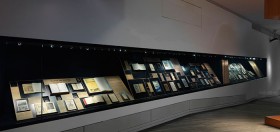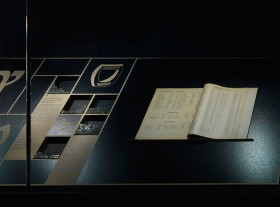
View of the cabinet exhibition “In a foreign country. Publications from the Displaced Persons Camps” in the basement of the Libeskind Building.
© Jewish Museum Berlin, photo: Jens Ziehe
In our cabinet exhibition “In a foreign country” we explore the publishing operations of survivors and refugees, the so-called displaced persons (DPs) who were stranded in occupied Germany after 1945. For this show we selected the widest variety of genres: schoolbooks, Judaica, volumes of poetry and prose, historical documentation, and Zionist pamphlets.
They all have two things in common: first, the quality of the paper these post-war printers used was extremely bad. Second, they all come from the Berlin State Library, whom we’re hosting for this exhibition due to its historically valuable collection of DP literature.
With one little exception. It started with our paper restorer’s helplessness when it came to fastening the very first exhibit, open, into the display case.
It was a list of the names of Jewish survivors. Before launching into the individual chapters of the exhibition, all pertaining to the “surviving remnant,” the “latest destruction,” education, emigration, religion, and tradition, we wanted to present this particular publication. It’s physically unremarkable and yet, for the survivors, a document of utmost importance. American military rabbi Abraham J. Klausner put together five such lists. When he’d reached the liberated concentration camp at Dachau in 1945, survivors had asked him to help them in the search for relatives. Page after page, the first and last name, date and place of birth together with current location (in most cases DP camps), are recorded.

The first object on display in the exhibition was ‘smuggled’ in from our holdings. Next to the opened list, you see Hebrew type from a range of the printers shown in the exhibition, as well as lead letters. These belong to the Jewish Museum Munich. They were used by the printing press Garfinkiel in Munich, which was founded by former DPs and published a Yiddish magazine “Naje jidische Zajtung” from 1950 to 1974.
© Jewish Museum Berlin, photo: Jens Ziehe
A nightmarish testimony to post-war reality. But only when it’s open. And the State Library’s copies of the five lists are bound together in a single volume that snaps closed when left on its own in the display case. Closed, it is less than unremarkable, like so much from that time, produced under precarious financial and technical conditions.
Then we realized that the Jewish Museum happens to have an edition of these five lists in its possession as well. They were part of a gift to our archive from Amos Klausner, the son of Abraham J. Klausner. And they were kept as five separate items. We decided on the spur of the moment to smuggle a copy from our holdings into the showcase. One of the lists was currently being restored so we couldn’t examine that one. But the third of the five printed lists actually made it into our exhibition: entitled “Sharit ha-Platah Bavaria,” it contains thousands of names of surviving Jews in Bavaria – that region’s “surviving remnant.”
You can visit the exhibition until 15 December 2015, in the basement level of the Libeskind Building, to get your own impression of this and other DP publications.
Exhibition curators Tamar Lewinsky and Ulrike Sonnemann were delighted by the success of their contraband smuggling, although they do usually read legally-purchased books.